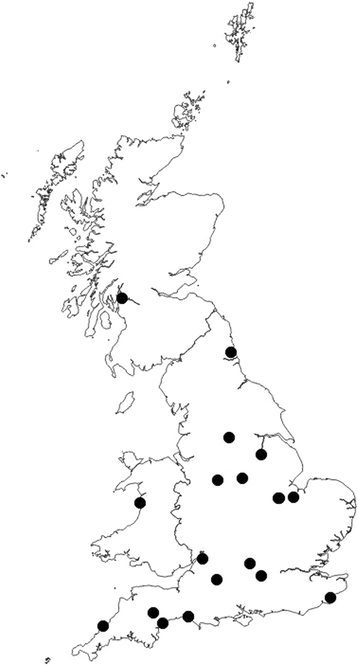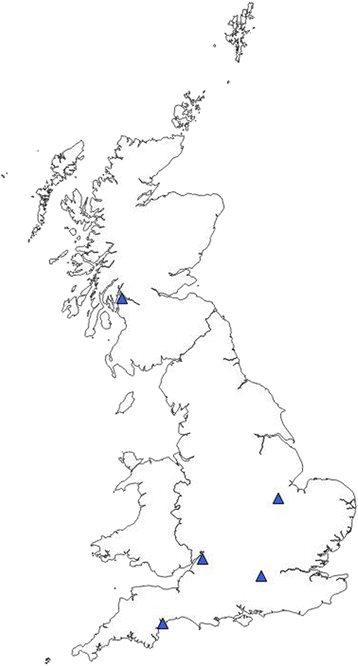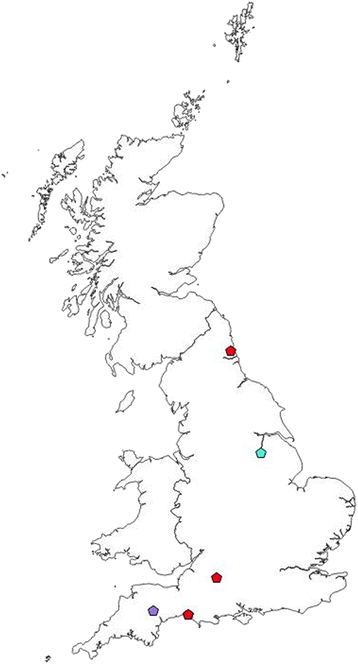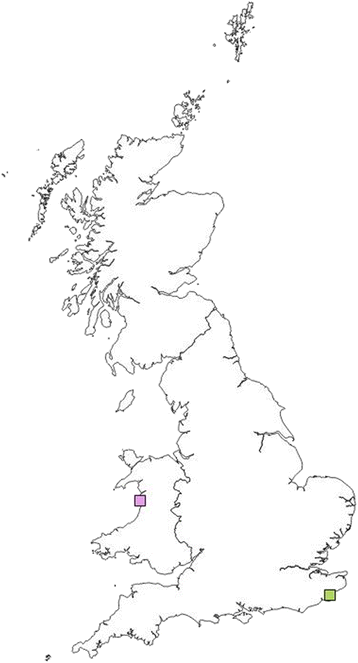Anaplasma phagocytophilum, Bartonella spp., haemoplasma species and Hepatozoon spp. in ticks infesting cats: a large-scale survey
- PMID: 29558992
- PMCID: PMC5861659
- DOI: 10.1186/s13071-018-2789-5
Anaplasma phagocytophilum, Bartonella spp., haemoplasma species and Hepatozoon spp. in ticks infesting cats: a large-scale survey
Abstract
Background: Ticks derived from cats have rarely been evaluated for the presence of pathogens. The aim of this study was to determine the prevalence of Anaplasma phagocytophilum, Bartonella spp., haemoplasma species and Hepatozoon spp. in ticks collected from cats in the UK.
Methods: Five hundred and forty DNA samples extracted from 540 ticks collected from cats presenting to veterinarians in UK practices were used. Samples underwent a conventional generic PCR assay for detection of Hepatozoon spp. and real-time quantitative PCR assays for detection of Anaplasma phagocytophilum and three feline haemoplasma species and a generic qPCR for detection of Bartonella spp. Feline 28S rDNA served as an endogenous internal PCR control and was assessed within the haemoplasma qPCR assays. Samples positive on the conventional and quantitative generic PCRs were submitted for DNA sequencing for species identification.
Results: Feline 28S rDNA was amplified from 475 of the 540 (88.0%) ticks. No evidence of PCR inhibition was found using an internal amplification control. Of 540 ticks, 19 (3.5%) contained DNA from one of the tick-borne pathogens evaluated. Pathogens detected were: A. phagocytophilum (n = 5; 0.9%), Bartonella spp. (n = 7; 1.3%) [including Bartonella henselae (n = 3; 0.6%) and Bartonella clarridgeiae (n = 1; 0.2%)], haemoplasma species (n = 5; 0.9%), "Candidatus Mycoplasma haemominutum" (n = 3; 0.6%), Mycoplasma haemofelis (n = 1; 0.2%), "Candidatus Mycoplasma turicensis" (n = 1; 0.2%), Hepatozoon spp. (n = 2; 0.4%), Hepatozoon felis (n = 1; 0.2%) and Hepatozoon silvestris (n = 1; 0.2%).
Conclusion: These data provide important information on the prevalence of tick-borne pathogens in ticks infesting cats, with the identification of haemoplasma species, A. phagocytophilum, H. felis and Bartonella spp. (including B. henselae and B. clarridgeiae). This study also documents the first report of H. silvestris in ticks collected from domestic cats.
Keywords: Anaplasma phagocytophilum; Bartonella clarridgeiae; Bartonella henselae; Feline; Haemoplasma; Hepatozoon felis; Hepatozoon silvestris; Mycoplasma haemofelis; Tick-borne pathogens; “Candidatus Mycoplasma haemominutum”; “Candidatus Mycoplasma turicensis”.
Conflict of interest statement
Ethics approval
Ethical approval for this study was given by the University of Bristol’s Animal Welfare and Ethical Review Body with the University Investigation Number UB/17/003.
Consent for publication
Not applicable.
Competing interests
ST and CH work for the Diagnostic Laboratories, Langford Vets, University of Bristol. The Laboratories provide a range of commercial diagnostic services including PCR and qPCR testing for
Publisher’s Note
Springer Nature remains neutral with regard to jurisdictional claims in published maps and institutional affiliations.
Figures





Similar articles
-
Prevalence study and risk factor analysis of selected bacterial, protozoal and viral, including vector-borne, pathogens in cats from Cyprus.Parasit Vectors. 2017 Mar 13;10(1):130. doi: 10.1186/s13071-017-2063-2. Parasit Vectors. 2017. PMID: 28285597 Free PMC article.
-
Clinical evaluation of outdoor cats exposed to ectoparasites and associated risk for vector-borne infections in southern Italy.Parasit Vectors. 2018 Mar 20;11(1):136. doi: 10.1186/s13071-018-2725-8. Parasit Vectors. 2018. PMID: 29554931 Free PMC article.
-
Prevalence of DNA of Mycoplasma haemofelis, 'Candidatus Mycoplasma haemominutum,' Anaplasma phagocytophilum, and species of Bartonella, Neorickettsia, and Ehrlichia in cats used as blood donors in the United States.J Am Vet Med Assoc. 2006 Sep 1;229(5):700-5. doi: 10.2460/javma.229.5.700. J Am Vet Med Assoc. 2006. PMID: 16948578
-
Potential for tick-borne bartonelloses.Emerg Infect Dis. 2010 Mar;16(3):385-91. doi: 10.3201/eid1603.081685. Emerg Infect Dis. 2010. PMID: 20202411 Free PMC article. Review.
-
Haemotropic mycoplasmas: what's their real significance in cats?J Feline Med Surg. 2010 May;12(5):369-81. doi: 10.1016/j.jfms.2010.03.011. J Feline Med Surg. 2010. PMID: 20417898 Free PMC article. Review.
Cited by
-
Transmission of Bartonella henselae within Rhipicephalus sanguineus: Data on the Potential Vector Role of the Tick.PLoS Negl Trop Dis. 2020 Oct 1;14(10):e0008664. doi: 10.1371/journal.pntd.0008664. eCollection 2020 Oct. PLoS Negl Trop Dis. 2020. PMID: 33001978 Free PMC article.
-
Tick-borne pathogens in Ixodidae ticks collected from privately-owned dogs in Italy: a country-wide molecular survey.BMC Vet Res. 2020 Feb 7;16(1):46. doi: 10.1186/s12917-020-2263-4. BMC Vet Res. 2020. PMID: 32028946 Free PMC article.
-
Molecular investigation reveals three hemotropic mycoplasmas in cats and three tick species in China.Front Vet Sci. 2025 Jan 30;12:1522904. doi: 10.3389/fvets.2025.1522904. eCollection 2025. Front Vet Sci. 2025. PMID: 39950087 Free PMC article.
-
Bartonella infections are rare in blood-fed Ixodes scapularis and Ixodes pacificus ticks collected from rodents in the United States.Parasit Vectors. 2024 Oct 29;17(1):442. doi: 10.1186/s13071-024-06541-w. Parasit Vectors. 2024. PMID: 39472944 Free PMC article.
-
Geographical isolation and hyperendemicity of Hepatozoon felis: Epidemiological scenario in Skopelos, Greece, and phylogenetic analysis.Curr Res Parasitol Vector Borne Dis. 2024 Jul 19;6:100202. doi: 10.1016/j.crpvbd.2024.100202. eCollection 2024. Curr Res Parasitol Vector Borne Dis. 2024. PMID: 39139660 Free PMC article.
References
Publication types
MeSH terms
LinkOut - more resources
Full Text Sources
Other Literature Sources
Miscellaneous

